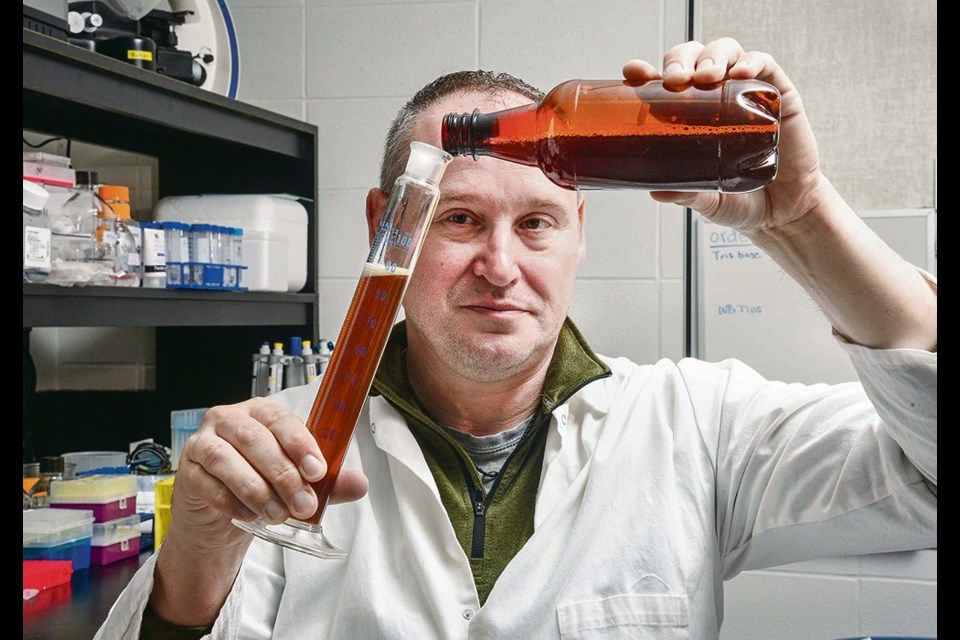SASKATOON — The world of beer is a world of endless flavours.
In fact, there’s even something called the that lists dozens of beer flavours from around the globe.
There are all sorts of unusual flavours on the wheel, including gooseberry, stone fruit and grassy.
But there’s one flavour that’s probably an acquired taste.
“After you’ve done a beer, you can age it in a barrel. Sometimes, craft brewers use a barrel that’s got a yeast called Brettanomyces in it,” said Chris Eskiw, an associate professor in Agriculture and Bioresources at the University of Saskatchewan.
“It (Brettanomyces) gives beer a really funky and earthy flavour…. The description in the handbook of flavours is barn floor or horse blanket.”
Why someone would want to drink a pint of horse blanket or barn floor is hard to explain.
But Eskiw and other beer experts do know what’s responsible for all the flavours on the wheel, even cheesy/sweaty socks.
It’s the yeast.
“Most people think that yeast is yeast is yeast,” said Eskiw, who has a PhD in cell biology from the University of Toronto.
It turns out that grocery store yeast, used to make bread, is not the same as brewer’s yeast.
“There are differences in the genetic (makeup) of these yeasts that allow them to do different jobs, under different conditions,” he said. “Like any good recipe you need good quality ingredients. And the malt certainly provides that material. But the yeast takes that raw material and converts them into many of the flavours… that we enjoy so much. The yeast are the little factories that give those beers their diversity.”
Many craft brewers and home brewers understand that different strains of yeast will impart different flavours, but few know why one type of yeast will produce a citrus taste and another will cause a caramel aroma.
Eskiw and his U of S colleagues are hoping to answer that question.
This year the Agricultural Development Fund in Saskatchewan provided Eskiw with $120,000 to study the relationship between beer styles and the genes in yeast.
For now, much of the knowledge around yeast is based on trial and error.
Brewers tried different types of yeast over decades or centuries until they found something that worked well for a particular type of beer — say a pilsner. They kept using the yeast because it imparted the desired flavour to the pilsner.
In many cases, brewers don’t share their trade secrets with other beer-makers.
“That’s why some craft brewers cultivate specific strains of yeast and guard them like trolls under a bridge,” says Vinepair.com, a website dedicated to beer and spirits.
The same is true for some large, commercial brewers, who keep their yeast private and proprietary.
“For example, Carling and Carlsberg out of Europe, they’re going to have their favourite house strains (of yeast) that perform really well with the recipe that they’re using,” Eskiw said.
“They’re not really going to share information on the genetics of that yeast… with other companies.”
Eskiw is hoping to make the connection between yeast genomics and beer quality more transparent, at least for craft brewers and home brewers in Canada.
He has been studying the genetic makeup of multiple strains of yeast to establish the yeast gene and flavour relationship. The plan is to publish a guidebook that brewers can use to select a yeast that is suited for their needs.
“If you try to use the lager yeast to make an ale, you’re going to end up with a horrible product,” Eskiw said. “We want to get that information out to the home brewers and craft brewers, so they can make better choices on those yeasts.”
Eskiw is doing the yeast research as a sideline to his main field of expertise — human longevity and diet.
He studies the interaction between a person’s genetic code and the food they consume and how that relationship effects their health.
“Understanding how our genes respond to nutrients is essential in order to design therapies/dietary strategies… and to identify foods to combat age-related disease and increase lifespan,” says his U of S webpage.
He came up with the idea to apply this research to yeast while drinking a beer.
“It was a question we had over a really good beer,” Eskiw said.
“We started to wonder how beers got their different flavours, and could we tailor that (relationship between yeast genes and flavour) to make better beers more reliably.”
As part of the research, Eskiw’s PhD student is working with a beer-maker in Saskatoon — 21st Street Brewery at the Hotel Senator — to study how the yeast is behaving in 600 litre and 1,300 litre brewing situations.
“(So) we can optimize and get better performance out of the yeast that they’re using in the brewery,” Eskiw explained.
By understanding the connection between yeast genes and beer flavour, it’s possible that craft brewers in Western Canada will develop new tastes and aromas. Or maybe they can improve upon the yeast that produces the “horse blanket” flavour so that the resulting beer tastes nothing like a horse blanket.
Yeast and beer: a basic guide
» Top-fermenting yeasts are used to make ales, stouts and wheat beers. These yeasts rise to the top during fermentation, hence the name. Top-fermenting yeasts perform well at room tempera- tures (18-22 C) and produce a thick head of yeast in early fermentation, which imparts more flavour to the beer.
» Bottom-fermenting yeasts are used to make pilsners and lagers. They ferment at the bot- tom of the fermenter and prefer cooler temperatures of about 7-15 C. Because the lager yeasts ferment more slowly and at cool- er temperatures, they produce fewer compounds and chemicals that impart flavour to the beer. That’s why pilsners and lagers have a cleaner taste than ales and stouts.
Source:

.JPG;w=120;h=80;mode=crop)


